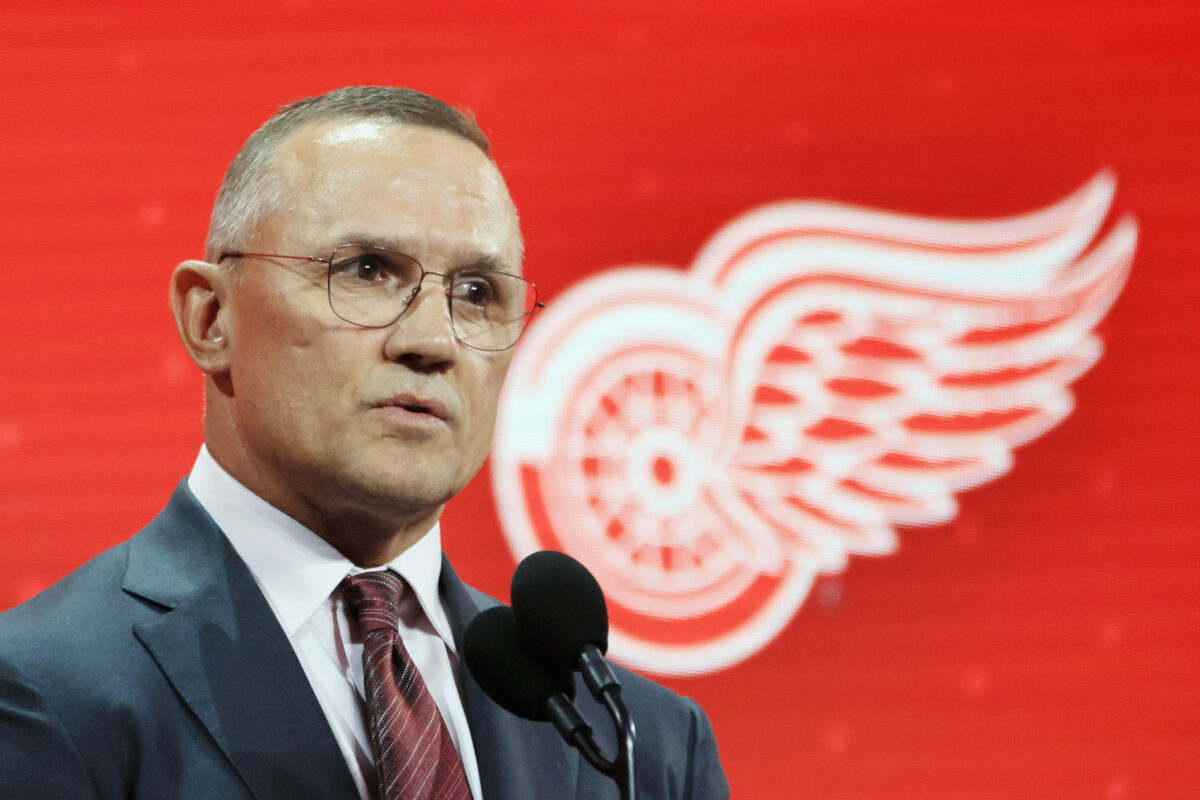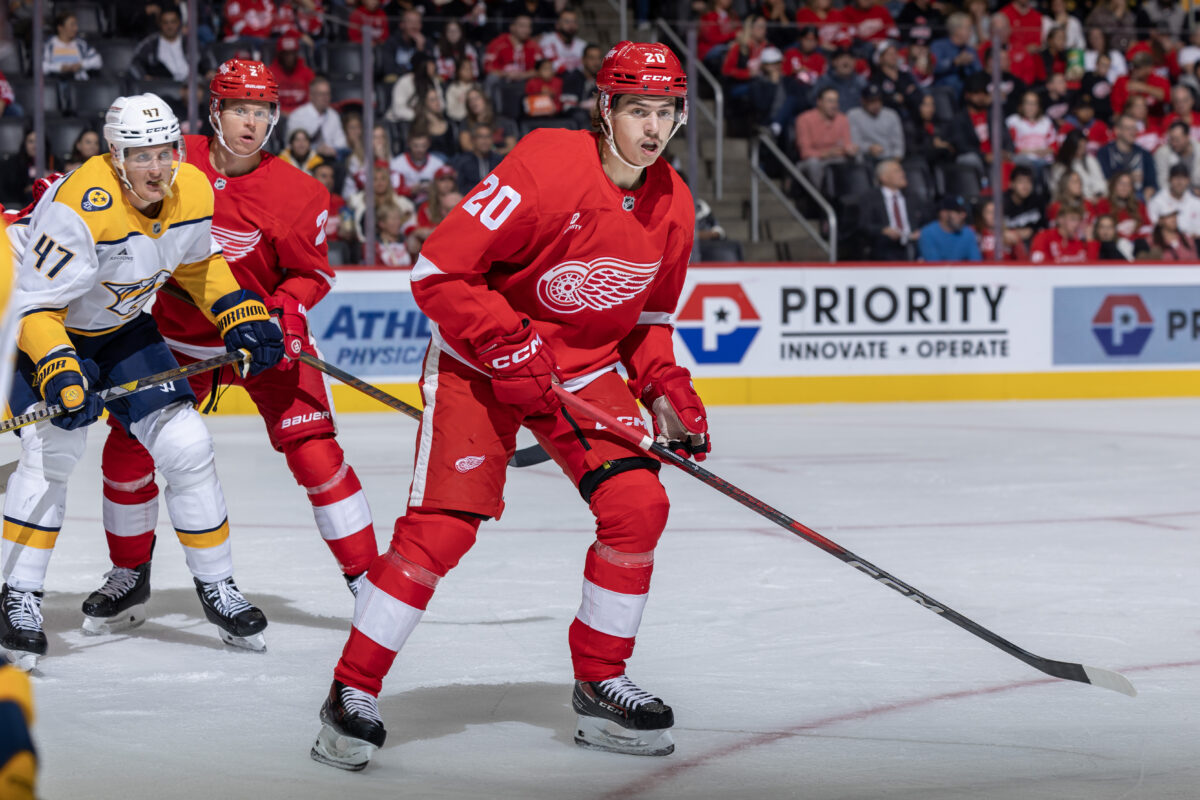When it comes to roster construction in the NHL, there’s an old saying: “you can’t build through free agency.” Basically, if a general manager (GM) has to rely on free agents to improve their roster, they’re not going to build something that will stand the test of time.
We’ve seen many examples of that principle. The Minnesota Wild were supposed to usher in a new era of chasing championships when they signed Zach Parise and Ryan Suter to 13-year contracts in the summer of 2012. Instead, they never made it past the second round of the playoffs, and both were bought out of their contracts in 2021. Numerous individual signings across the league have been heralded by their specific markets, only for those contracts to look like wedding day acne within a season or two.
The Detroit Red Wings are not immune to this phenomenon. Over the last decade, fans across “Hockeytown” have seen their team sign Stephen Weiss and then buy him out after two years of a five-year contract back in 2015. Frans Nielsen was signed to a six-year pact in 2016, but was bought out with a year left on the deal. Even now, the Red Wings have a few contracts on their books that are producing negative value for the organization, which only exacerbates the fact that Detroit is near the top of the league in terms of payroll this season, thus leaving them very little room to work with under the salary cap.
But all of that would be fine if the team was chasing championships. The nature of a salary cap league is that Stanley Cup contenders are usually at or near the cap while rebuilding teams typically have plenty of leg room to maneuver their roster. The Red Wings, with a playoff drought that is quickly approaching a decade, are closer to the latter than the former. That creates a problem, one which has become a focus of much consternation across the fanbase: with the Red Wings’ heavy focus on bringing in free agents over the last few seasons, the results do not line up with the cap sheet.
That is especially a problem when you consider how many prospects on cheap rookie contracts look ready to contribute in the NHL.
Yzerman’s Free Agent Record
Before we can take a look at the free agent contracts that are currently hindering the Red Wings, it is important to note that not all free agent signings are created equal. Just as some signings are done to acquire the “missing piece” a team needs to start competing for championships, other players are signed with the intention of raising a team’s floor or to fill a specific role. Free agency is a tool and, like any tool, it is how someone uses it that determines how successful it is at solving a problem.
Related: How the Red Wings’ Forwards Stack Up in the Atlantic Division
Of the Red Wings’ 12 forwards that made the 2024-25 opening night roster, half of them were acquired through free agency. Half of the team’s eight defensemen were signed as free agents, and two of their three goalies were also brought in through the free agent market. Overall, 12 of their 23 rostered players were signed as free agents, compared to the eight that were drafted and developed by the Red Wings. If that isn’t building a team through free agency, I don’t know what is.
Some of the Red Wings’ free agent deals present great value and won’t hinder the team long-term. Patrick Kane’s incentive-filled, one-year contract was basically the best-case scenario for the organization after the future hall-of-famer was a seamless fit with the team across 50 games last season. Winger Vladimir Tarasenko signed a two-year deal back in July, and he should provide enough offensive punch over this season and next to make his $4.75 million hit against the salary cap worth it. With a two-year deal that carries a cap hit of $2.5 million, goaltender Cam Talbot really only needs to perform at a league-average rate to justify his contract.
All of this is to say that Red Wings GM Steve Yzerman has certainly signed some quality free agent deals during his tenure, with those three being recent examples. However, success often comes hand-in-hand with failure, and the Red Wings’ cap sheet contains a few contracts that won’t be celebrated like the ones in the previous paragraph.

Within the first week of the 2024-25 season, the Red Wings waived two players: defenseman Justin Holl and goaltender Ville Husso. Husso, who is in the final year of a three-year contract, was acquired from the St. Louis Blues during the 2022 NHL Draft and promptly signed to his current contract despite playing in just 57 NHL games to that point. That he found himself on waivers this early into the third year on his contract should tell you how the deal has aged, but he ultimately wasn’t a free agent signing, and the move to acquire him made sense at the time because the team needed more depth in the crease and they didn’t have a goalie prospect ready for a look in the NHL.
Holl, on the other hand, is in the second year of a three-year pact he made with the Red Wings last summer. Despite carrying a $3.4 million cap hit, the 32-year-old defenseman played in just 38 games with Detroit last season, sitting as a healthy scratch for large chunks of the season. The organization decided to keep him around during the summer despite the opportunity to buy him out, but the veteran of over 300 NHL games was unable to secure a roster spot in training camp. Luckily, it appears that he has some early chemistry with Simon Edvinsson that may prove to be his ticket back to a full-time spot in the NHL.
Andrew Copp is getting paid over $5.6 million to be a bottom six center and he is signed until 2027. Erik Gustafsson and Olli Määttä combine for a $5 million cap hit and both look like they could be in and out of the lineup at times this season. Total all of these deals up and one truth becomes clear: one or two bad contracts aren’t the end of the world, but you can only accrue so much negative value before you’re forced to perform salary cap gymnastics while icing a suboptimal roster.
Yzerman’s Drafting Record
The saying is that you can’t build through free agency, but another statement is also popular across all of sports: “to acquire high-end players, you have to build through the draft.
Think about this: almost every franchise icon in the Red Wings’ long history was drafted by the organization. Nicklas Lidstrom, Pavel Datsyuk, Sergei Fedorov, Henrik Zetterberg, Dylan Larkin and even Yzerman himself were all drafted and developed by the Red Wings and went on to become cornerstones of their respective eras. With the exception of Larkin for obvious reasons, all of these players were surrounded by talent the organization had developed, and then outside help was brought in to pull it all together.
As GM, Yzerman has had success with identifying talent in the draft. There are many examples going back to his time as GM of the Tampa Bay Lightning, and even though there aren’t as many examples since he took the Red Wings job in 2019, the examples that are there are enough to prove the point.
Yzerman’s very first pick as GM of the Red Wings was defenseman Moritz Seider. After the Red Wings selected Seider with the sixth pick of the 2019 draft, the German defender spent the next two seasons developing before arriving in the 2021-22 NHL season. He went on to win the Calder Trophy as the league’s top rookie, becoming the Red Wings’ first Calder Trophy winner since the Expansion Era began.
Lucas Raymond, the organization’s highest pick in the draft since the 20th century, was a finalist for the Calder Trophy that same 2021-22 season, and has since asserted himself as a legitimate top six winger that has undeniable chemistry with Larkin. Seider and Raymond’s impact on the team has been so great that they became the team’s second and third-highest paid players, respectively, before the start of this season.
Two Red Wings-drafted players have joined the team’s roster this season: Edvinsson and Albert Johansson. While Edvinsson’s pedigree as the team’s top pick in the 2021 draft made him a shoo-in for a full-time role this season, Johansson’s spot wasn’t as secure. Just two games into the season, however, we may be seeing why that never should have been the case.
Red Wings’ Future Could Be Now
Ahead of the 2024-25 season, Yzerman’s mandate was for the Red Wings to improve their defensive play. While some of that improvement falls on coaching and continued growth from some of the team’s young players, the front office also bares some responsibility.
With Edvinsson, Johansson and even forward prospect Marco Kasper all looking NHL-ready and capable of being plus players in their own zone, Yzerman instead looked to free agency, bringing in Gustafsson and forward Tyler Motte to address some of the team’s defensive holes. While Motte has been fine on the team’s fourth line and is not impeding Kasper’s progress, Johansson replaced Gustafsson after the team’s first game and immediately helped improve the team’s defensive play.
Through his first two NHL games, the Red Wings are outshooting their opponents 12-6 with Johansson on the ice. Detroit was outshot 8-5 with Gustafsson on the ice in their opening night contest against the Pittsburgh Penguins. While Johansson played less than 12 minutes in both games, there is early proof that the team’s desire to improve defensively would be better served with Johansson in the lineup than with Gustafsson.

While Yzerman was probably never going to be comfortable with the idea of leaving a spot open for Johansson, the Gustafsson signing already seems redundant. Both Johansson and Holl have outperformed Gustafsson in the defensive end early on, and the offense Gustafsson provides could probably be replicated by Edvinsson or someone else if given the chance. That’s also without mentioning the benefits of NHL game reps that Edvinsson and Johansson need to cement themselves as part of the solution for this Red Wings team.
This all circles back to the point that began this article. The expectation in Detroit is for the Red Wings to make the playoffs this season. While that isn’t the same as contending for a championship, it is the first significant step towards it. If you cannot build a contender through free agency and you are trying to open up a window to contend, it is time to start investing in the talent pool you have accumulated through the draft – especially when every indication so far is that you’ve been drafting pretty well.
This is especially important to keep in mind as the Red Wings currently project to have around $20 million in cap space next summer, which is plenty of spending power in a free agent class that currently projects to have more than a handful of noteworthy names. At a time where the fruits of Detroit’s rebuild are finally positioned to propel the team forward, the organization must be careful to balance the opportunity to augment their lineup with high-end free agents with the reality that they have several prospects that will be pushing for jobs over the next couple of years.
There are multiple ways to invest in a team’s future, but some are riskier than others.
